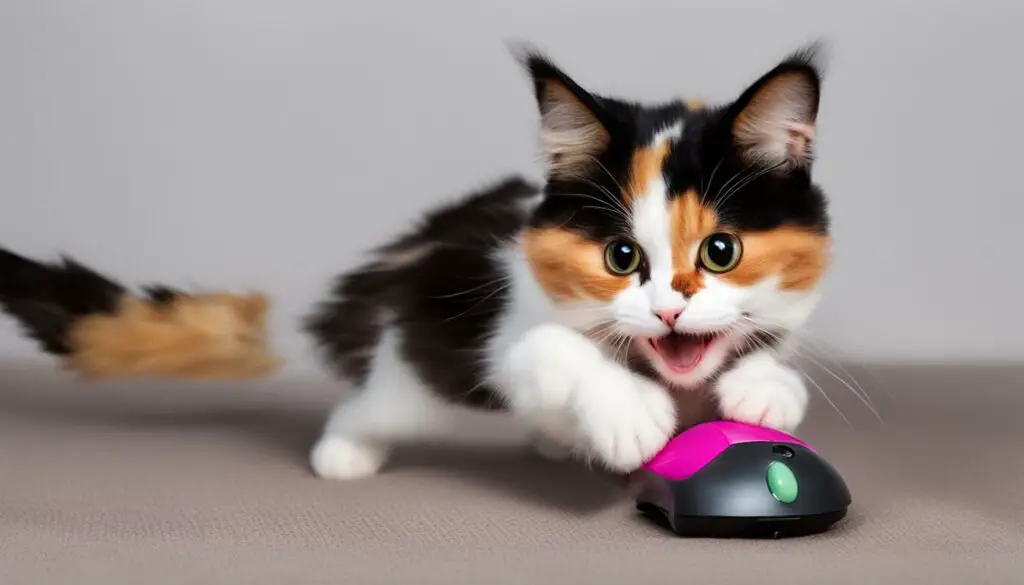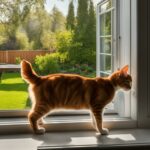Cats are fascinating creatures with their own unique ways of communication. As cat owners, we often find ourselves puzzled by the strange noises our feline friends make during playtime. Why do they produce such unusual sounds? What do these vocalizations mean? In this article, I will delve into the world of cat vocalizations during play and shed light on the reasons behind these enigmatic sounds.
Key Takeaways:
- Understanding cat vocalizations during play is crucial for ensuring the well-being of our feline friends.
- There are various factors that contribute to strange cat noises, including age, health issues, breed characteristics, and communication purposes.
- Monitoring and interpreting your cat’s meows during play can help you respond to their needs and emotions effectively.
- If your cat’s meow sounds broken or distorted during play, it is important to consult with a veterinarian to rule out any potential health problems.
- Creating a peaceful play environment and providing mental and physical stimulation can help reduce broken meow sounds and promote overall well-being.
The Mystery of Broken Meow Sounds in Cats
When it comes to playtime, cats often make strange and broken meow sounds that can puzzle their owners. These unusual vocalizations may sound alarming, but they are actually quite common. Understanding the reasons behind broken meow sounds can help us provide the best care for our feline friends.
There are several factors that can contribute to broken meow sounds in cats. One possible cause is age. As cats get older, their vocal cords may undergo changes, leading to a raspier or hoarser voice. This can result in meows that sound broken or distorted during play. It’s important to monitor any sudden or significant shifts in your cat’s meow sounds, as it could be a sign of underlying health issues.
Additionally, certain health problems can affect the quality of a cat’s meow. Respiratory infections, thyroid problems, and vocal cord issues are just a few examples of conditions that can lead to broken meow sounds. If your cat’s meows sound broken or distorted during play and there are no other apparent reasons, it’s crucial to consult with a veterinarian to rule out any potential health problems.
| Cause | Examples |
|---|---|
| Age-related changes | Raspier meow, hoarser voice |
| Health issues | Respiratory infections, thyroid problems, vocal cord issues |
Understanding the underlying causes of broken meow sounds in cats is essential for providing appropriate care and attention.
In conclusion, broken meow sounds in cats during playtime can be a result of various factors such as age, health issues, or breed characteristics. By being aware of these factors and closely monitoring our cats’ meow sounds, we can ensure their well-being and address any potential concerns. Remember to consult with a veterinarian if you have any doubts or if the broken meow sounds persist despite your efforts.

Aging and its Impact on Cat Meows
As cats age, it is not uncommon for their meows to undergo changes. One noticeable difference is a raspier meow or a hoarser voice. These changes in cat meows with age can be attributed to natural processes in the vocal cords. Just like humans, cats experience wear and tear over time, which can result in an altered sound.
It is important to be aware of these changes and monitor any sudden or significant shifts in your cat’s meow as it could be a sign of underlying health issues. While a raspier meow is generally considered normal in older cats, it is crucial to rule out potential problems that may be causing the change in vocalization.
Regular veterinary check-ups are essential for aging cats. A veterinarian can assess your cat’s overall health, including their vocal cords, and make recommendations if necessary. By staying vigilant and seeking professional help when needed, we can ensure the well-being of our aging feline friends.
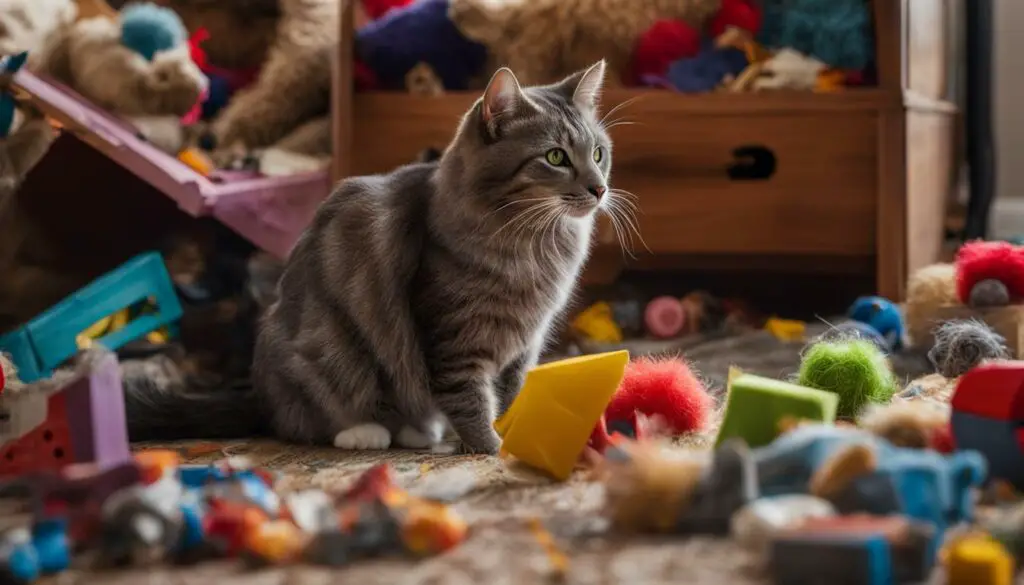
The Impact of Aging on Cat Meows:
| Age | Common Changes in Meow |
|---|---|
| Senior Cats | Raspier or hoarser voice |
| Elderly Cats | Further changes in vocalization, potential signs of health issues |
It’s important to remember that every cat is unique, and the extent and timing of these changes can vary. Some cats may experience age-related vocalization changes earlier in life, while others may maintain their meow sound throughout their senior years. By understanding and being attentive to these changes, we can provide the appropriate care and support to our aging cats.
Health Issues that Affect Cat Meows
Cats are known for their vocal nature, but sudden or unusual changes in their meows during playtime may be a sign of underlying health issues. Respiratory infections, thyroid problems, and vocal cord issues are some of the common health conditions that can affect a cat’s meow. If your cat’s meow sounds broken or distorted during play and there are no other apparent reasons, it is important to consult with a veterinarian to rule out any potential health problems.
Respiratory infections, such as upper respiratory tract infections or feline viral rhinotracheitis, can cause congestion and inflammation in a cat’s airways, leading to changes in their meow sounds. Symptoms may include sneezing, coughing, and nasal discharge. Early detection and appropriate treatment are essential to prevent complications and ensure a speedy recovery.
Thyroid problems, specifically hyperthyroidism, can also impact a cat’s vocalizations. This condition occurs when the thyroid gland produces an excessive amount of thyroid hormone. Cats with hyperthyroidism may experience weight loss, increased appetite, restlessness, and changes in vocalizations, including a more hoarse or raspy meow.
Vocal cord issues, such as polyps or nodules, can affect a cat’s ability to produce clear and normal meow sounds. These growths or abnormalities can cause changes in the structure and function of the vocal cords, resulting in broken or distorted meows. Surgery or other medical interventions may be necessary to address vocal cord issues in cats.
| Health Issue | Symptoms | Treatment |
|---|---|---|
| Respiratory infections | Sneezing, coughing, nasal discharge | Antibiotics, supportive care |
| Thyroid problems (hyperthyroidism) | Weight loss, increased appetite, restlessness | Medication, radioactive iodine therapy, surgery |
| Vocal cord issues | Changes in vocalization, growths or abnormalities | Surgery, medical interventions |
Breeds with Unique Meow Sounds
Certain cat breeds, such as Siamese cats, are known for their unique meow sounds. Siamese cats have a distinct, raspy meow that sets them apart from other breeds. Understanding the breed characteristics and their vocalizations can help cat owners better appreciate and interpret the strange meow sounds during play.
The Raspy Meows of Siamese Cats
Siamese cats are known for their distinctive vocalizations, which often sound raspy and intense. Their meows can range from loud and demanding to soft and expressive. The unique tone and quality of their meows can be attributed to both genetic factors and physical attributes.
Siamese cats have a genetic predisposition that affects the development of their vocal cords, resulting in their distinct meow sounds. Additionally, their slender bodies and large ears contribute to the unique resonance and amplification of their meows.
| Breed | Distinctive Meow Sounds |
|---|---|
| Siamese Cats | Raspy and intense meows |
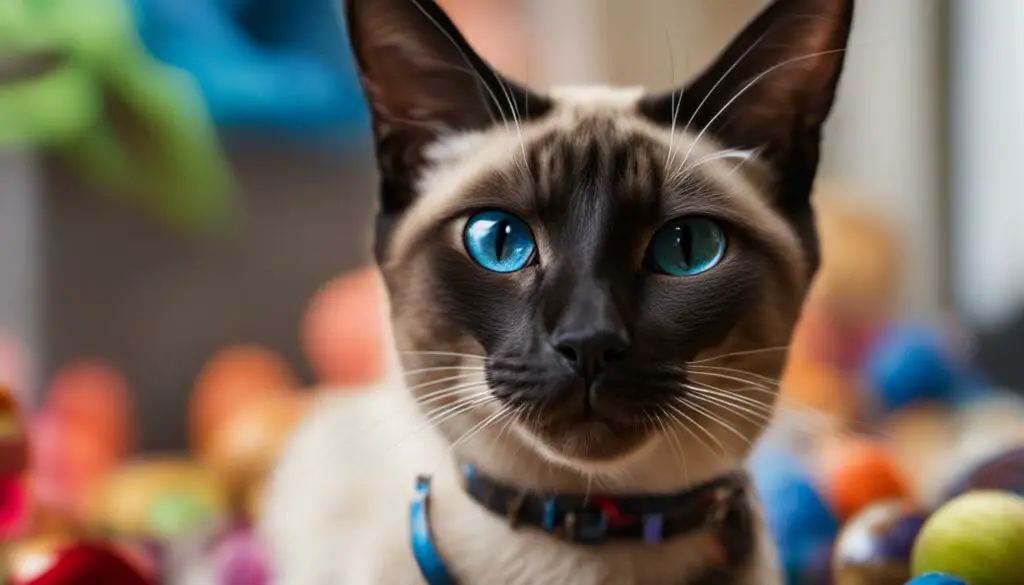
“Siamese cats are known for their distinctive vocalizations.”
Siamese cats are highly sociable and enjoy interacting with their human companions. Their vocalizations serve as a means of communication, expressing their needs, desires, and emotions. The meow sounds during playtime can be a way for Siamese cats to engage with their owners and seek attention or participation in their playful activities.
By understanding the unique meow sounds of Siamese cats and their communicative purposes, cat owners can develop a deeper bond with their feline companions and respond to their needs more effectively during playtime.
The Purpose and Meaning Behind Cats’ Playtime Vocalizations
Cats are known for their unique vocalizations, and this extends to their playtime meows. These meows serve as a form of communication, allowing cats to express their needs, desires, and emotions during play. Understanding the purpose and meaning behind these vocalizations is essential for cat owners to better interpret and respond to their feline companions.
When cats meow during play, they are often attempting to communicate with their human or feline playmates. These meows can express excitement, anticipation, or a desire for interaction. By paying attention to the context and nuances of the meows, cat owners can better understand what their cats are trying to convey.
It’s important to note that the meaning behind playtime vocalizations can vary from cat to cat. Some cats may use meows as a way to initiate play or signal their readiness for a particular activity. Others may use meows to express their satisfaction or enjoyment during play. By observing your cat’s body language, behavior, and vocalizations, you can gain valuable insights into their playtime communication.
| Playtime Meow Meaning | Description |
|---|---|
| Excitement | Cats may meow with high-pitched sounds and increased energy to express their excitement during play. |
| Engagement | Meows can be a way for cats to engage with their playmates, signaling their desire for interaction and fun. |
| Request for Attention | Cats may use meows to get their owner’s attention during play, indicating they want to continue or modify the activity. |
| Satisfaction | Contented meows during play can indicate that a cat is enjoying the activity and is in a relaxed state. |
Interpreting cat vocalizations during play requires observation and familiarity with your cat’s individual behaviors and preferences. By understanding the purpose and meaning behind their meows, you can strengthen your bond with your cat and ensure a fulfilling and enjoyable playtime experience for both of you.
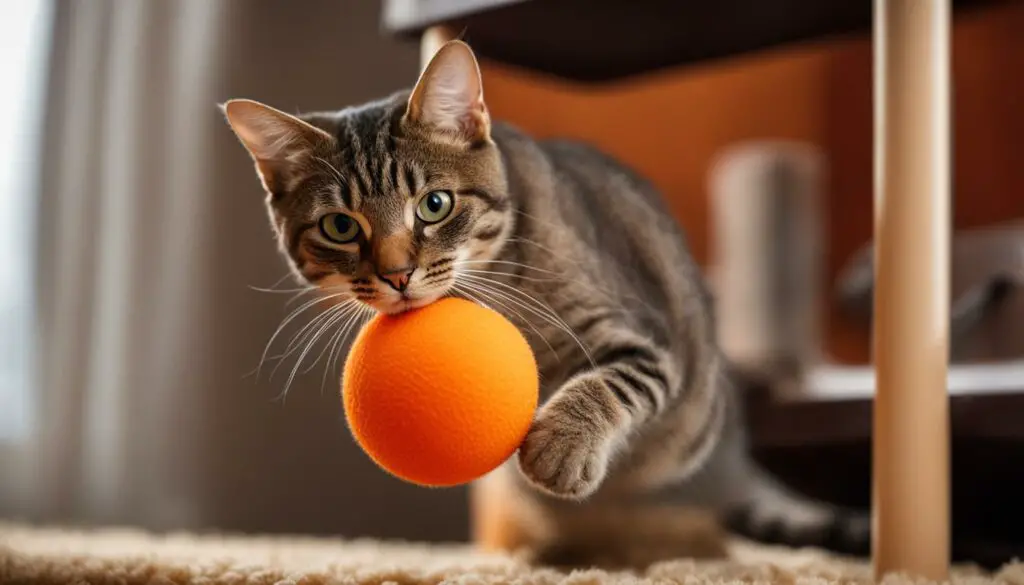
Identifying Stress and Anxiety in Cat Vocalizations
Cats are highly sensitive creatures, and they can express their emotions through various vocalizations. When a cat meows in an unusual or broken manner during playtime, it could be a sign of stress or anxiety. As a responsible cat owner, it’s important to be able to identify these signs and take appropriate action to alleviate their distress.
Cat meows as a sign of stress can manifest in different ways. They may sound strained, high-pitched, or repetitive. These meows can occur during play or in other situations, indicating that your cat is feeling overwhelmed or threatened. It’s crucial to pay attention to your cat’s body language and overall behavior during playtime to determine if they are experiencing stress or anxiety.
Some common signs of stress in cats include excessive grooming, hiding, aggression, and changes in appetite or litter box habits. If you notice any of these behaviors, along with unusual meow sounds, it’s essential to create a calm and peaceful environment for your feline companion. Providing them with a safe space, engaging in regular interactive play sessions, and using calming techniques such as pheromone diffusers can help reduce their stress levels.
| Signs of Stress in Cats | Actions to Alleviate Stress |
|---|---|
| Excessive grooming | Provide mental and physical stimulation |
| Hiding | Create a calm and safe environment |
| Aggression | Use pheromone diffusers or calming sprays |
| Changes in appetite or litter box habits | Engage in regular interactive play sessions |
In some cases, seeking the help of a professional, such as a veterinarian or a certified animal behaviorist, may be necessary to address your cat’s stress or anxiety. They can provide a thorough evaluation of your cat’s overall health and behavior, and recommend appropriate interventions or treatments. Remember, a calm and stress-free environment is vital for your cat’s well-being, and by identifying and addressing their stress and anxiety, you can help create a harmonious playtime experience for both of you.

Addressing Broken Meow Sounds: Tips and Solutions
When your cat’s meow sounds broken or distorted during play, it can be a cause for concern. Fortunately, there are several steps you can take to address this issue and provide the necessary care for your feline friend. Here are some tips and solutions to help manage broken meow sounds in cats:
1. Regular veterinary check-ups: Schedule regular check-ups with your veterinarian to ensure your cat’s overall health. Your vet can assess any underlying medical conditions that may be causing the broken meow sounds and provide appropriate treatment.
2. Manage stress and anxiety: Cats can meow differently when they’re feeling stressed or anxious. Create a peaceful environment for your cat, provide hiding spots, and engage in interactive play to reduce stress levels and promote a sense of calm.
3. Create a positive play environment: Cats need mental and physical stimulation during playtime. Offer a variety of toys, scratching posts, and interactive play sessions to keep them engaged. This can help alleviate any frustration or boredom that may contribute to broken meow sounds.
4. Provide mental and physical stimulation: Ensure your cat has plenty of opportunities for exercise and mental stimulation. This can include puzzle toys, treats, and playtime that mimics hunting behavior. By keeping your cat physically and mentally active, you can help reduce broken meow sounds during play.
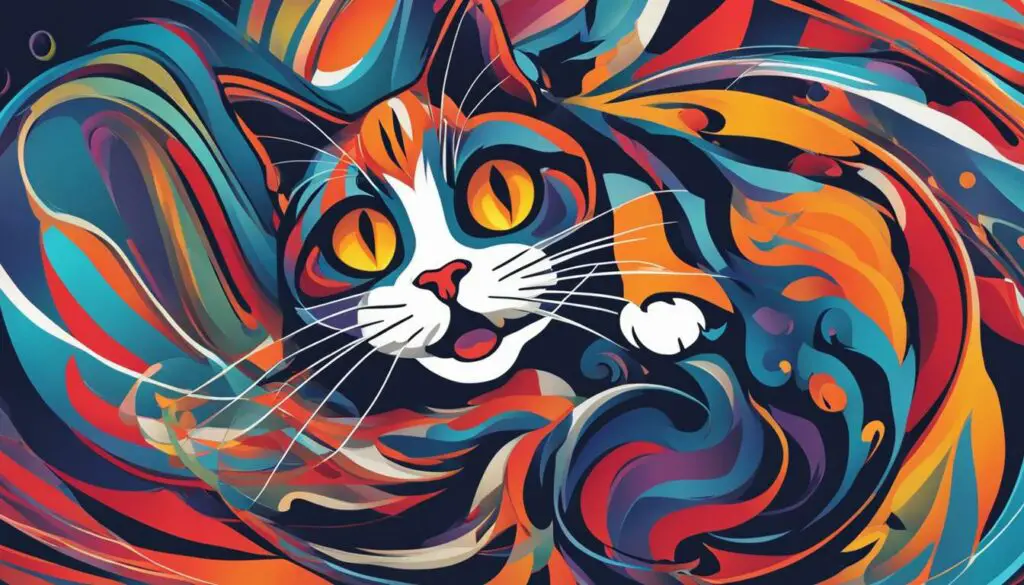
By implementing these tips and solutions, you can address and manage the broken meow sounds in your cat. Remember, every cat is unique, so it’s important to observe your cat’s behavior and adjust your approach accordingly. If the issue persists or worsens, consulting with a veterinarian is always recommended to ensure your cat’s health and well-being.
Providing Veterinary Care for Broken Meow Sounds
If your cat’s meow continues to sound broken or distorted despite your efforts, it is important to consult with a veterinarian. A vet can evaluate your cat’s overall health and provide specific advice or treatment for addressing the broken meow sounds. Professional help ensures that any underlying health issues are identified and addressed appropriately.
Consulting with a veterinarian for broken meow sounds is crucial in determining the cause of these unusual vocalizations. The vet will conduct a thorough medical evaluation to rule out any underlying health conditions that may be contributing to the broken meow sounds. They will examine your cat’s vocal cords, respiratory system, and overall physical health to identify any potential issues.
Seeking professional help for broken meows is essential as it allows for proper diagnosis and treatment. The vet may recommend additional tests, such as blood work or imaging, to get a comprehensive understanding of your cat’s health. Based on the findings, they can provide specific guidance on how to manage or address the broken meow sounds and improve your cat’s overall well-being.
Remember, veterinary care is crucial in ensuring the health and happiness of your feline companion. By consulting with a veterinarian and seeking their professional expertise, you can effectively address the broken meow sounds and provide the best possible care for your cat.
table {
border-collapse: collapse;
width: 100%;
}
th, td {
text-align: left;
padding: 8px;
}
th {
background-color: #f2f2f2;
}
| Veterinary Care for Broken Meow Sounds |
|---|
| Consulting with a veterinarian |
| Seeking professional help for broken meows |
| Medical evaluation for strange cat vocalizations |
Understanding the Importance of Monitoring Cat Vocalizations
When it comes to our feline companions, monitoring their vocalizations is an essential part of understanding their needs and overall well-being. Recognizing changes in meow sounds and observing cat behavior during play can provide valuable insights into their health and emotional state. Cats use vocalizations as a means of communication, and by paying attention to their meows during playtime, we can better understand and respond to their needs.
One way to monitor cat vocalizations is by recognizing changes in meow sounds. Cats may have different types of meows, each carrying a specific message. By familiarizing ourselves with their repertoire of meow sounds, we can interpret their communication more accurately. If we notice sudden changes in their meow sounds during play, such as broken or distorted meows, it could indicate underlying health issues or emotional distress.
Observing cat behavior during play is another crucial aspect of monitoring their vocalizations. Cats’ body language can provide valuable clues about their well-being. If a cat’s meow sounds broken or distorted during play, it is important to observe their behavior for any signs of discomfort or unusual aggression. Additionally, paying attention to their overall energy levels and engagement during playtime can help us gauge their physical and emotional state.
Recognizing Changes in Meow Sounds
Monitoring cat vocalizations involves recognizing changes in meow sounds during play and other activities. Here are some signs to look out for:
- Broken or distorted meow sounds: If your cat’s meow sounds different than usual, such as being hoarse or raspy, it could indicate underlying health issues.
- Sudden changes in frequency or intensity: If your cat’s meow becomes louder, softer, or more frequent, it could be a sign of emotional distress or discomfort.
- Changes in body language: Pay attention to your cat’s posture and facial expressions while vocalizing. If they appear tense, agitated, or in pain, it may be related to their vocalizations.
By being attentive to these changes in meow sounds and observing their behavior, we can better understand our cats’ needs and provide them with the necessary care and attention.
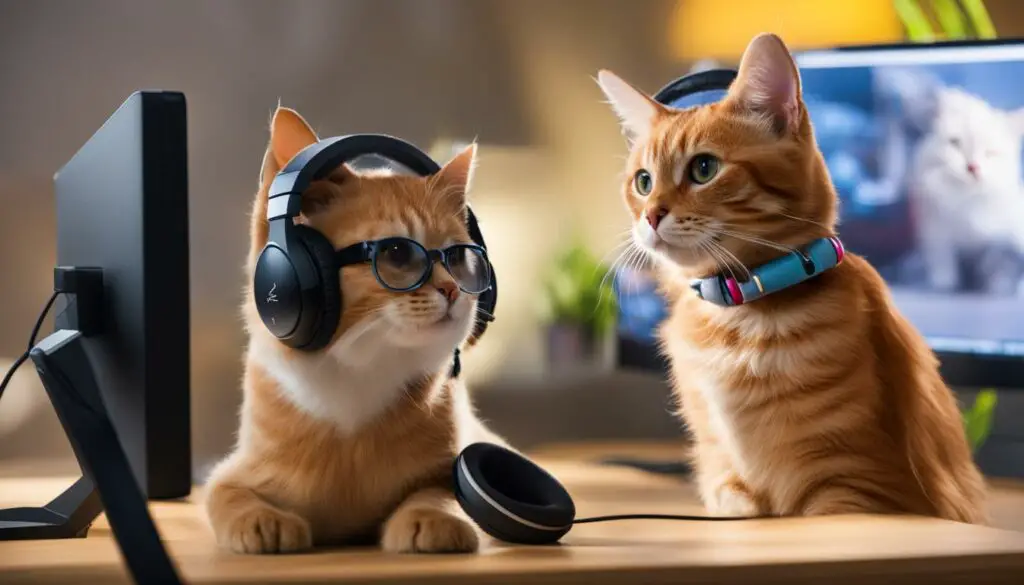
Summary
Monitoring cat vocalizations, recognizing changes in meow sounds, and observing cat behavior during play are essential in ensuring the well-being of our feline friends. By paying attention to their vocalizations and behavior, we can better understand their needs, identify any potential health issues, and provide the necessary care and attention. Remember, each cat is unique, so it’s important to familiarize ourselves with their individual vocalizations and body language to create a harmonious and fulfilling play environment.
The Unique Meow Sounds of Siamese Cats
Siamese cats are known for their distinct meow sounds, which set them apart from other breeds. These peculiar vocalizations often catch the attention of cat owners and intrigue those who are unfamiliar with the breed. Understanding the characteristics of Siamese cat vocalizations can provide valuable insights into their communication style and help interpret their meows during play.
The meow sounds of Siamese cats are often high-pitched and louder compared to other cats. This unique trait can be attributed to a combination of genetic factors, physical attributes, and behavioral aspects. Siamese cats have slender bodies and large ears, which contribute to the distinct sound of their meows. Their vocal cords are genetically predisposed to produce a particular range of sounds, resulting in their characteristic meow.
When engaging in playtime, Siamese cats may use their meows as a means of communication. Their vocalizations can convey excitement, playfulness, or even a desire for attention. By paying attention to the context and nuances of their meows, cat owners can better understand their Siamese companions and strengthen the bond they share.
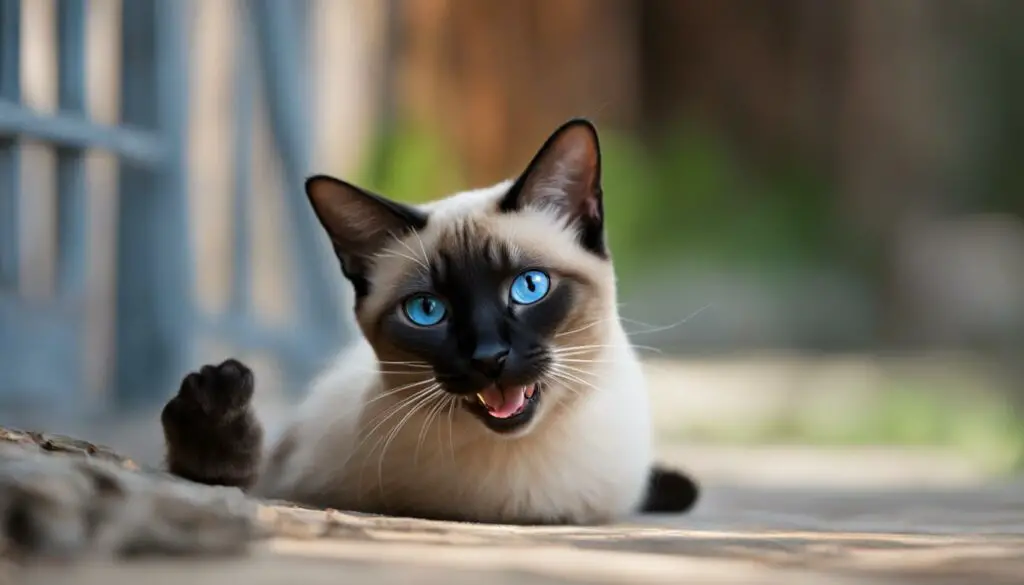
| Characteristics of Siamese Cat Vocalizations | Description |
|---|---|
| High-Pitched | Siamese cats have meows that are typically higher in pitch compared to other breeds. |
| Louder | The volume of Siamese cat meows is often louder and more pronounced than that of other cats. |
| Expressive | Siamese cats use their meows to express emotions, such as excitement, happiness, or longing. |
| Communicative | Siamese cat meows serve as a form of communication with their human companions, conveying their needs and desires. |
Overall, the unique meow sounds of Siamese cats add to their charm and individuality. Understanding and appreciating their vocalizations can enhance the bond between cat and owner, allowing for better communication and a more enriching playtime experience.
The Reasons Behind Siamese Cats’ Distinct Meow
Siamese cats are known for their distinct meow sounds, which set them apart from other breeds. The uniqueness of their meows can be attributed to various factors, including genetic factors, physical attributes, and behavioral aspects.
Genetic factors play a significant role in shaping the vocalization of Siamese cats. These cats possess a specific gene that affects the development and function of their vocal cords, resulting in the distinct sound of their meows. This genetic characteristic is responsible for the high-pitched and often louder meows that Siamese cats are known for.
In addition to genetic influences, the physical attributes of Siamese cats contribute to their unique meow sounds. Siamese cats have relatively slender bodies and large ears, which affect the resonance and projection of their vocalizations. These physical features further enhance the distinctiveness of their meow sounds.
Furthermore, the behavior of Siamese cats also plays a role in their meow sounds. Siamese cats are known for their sociability and desire for human interaction. Their meows serve as a means of communication, often expressing their needs and desires. This behavior further emphasizes the unique vocalizations of Siamese cats during playtime and other interactions.

Table: Factors Contributing to Siamese Cats’ Distinct Meow
| Factors | Description |
|---|---|
| Genetic Factors | Influence the development and function of vocal cords |
| Physical Attributes | Slender bodies and large ears affect resonance and projection of vocalizations |
| Behavior | Sociability and desire for human interaction result in unique meow sounds |
Understanding the reasons behind Siamese cats’ distinct meow can help cat owners better appreciate and interpret their vocalizations. The combination of genetic factors, physical attributes, and behavior aspects contributes to the unique and characteristic meow sounds of Siamese cats, making them truly special companions.
Social Traits and Communicative Purposes of Siamese Cat Meows
Siamese cats are known for their unique meow sounds that are distinct from other breeds. These social felines have a rich repertoire of vocalizations that serve various communicative purposes. By understanding the social traits and communicative purposes of Siamese cat meows, we can deepen our bond with these affectionate companions during play.
Bonding Through Meow Sounds
Siamese cats are highly social and thrive on human companionship. They often use their meows as a means of bonding with their owners during play. The melodic and sometimes chatty nature of their meows reflects their desire to interact and communicate. When a Siamese cat meows during play, they are inviting their human companion to engage and share in the joy of the moment. By reciprocating their meows and responding with affection, we can strengthen the bond and create a deeper connection with our Siamese friends.
Expressing Needs and Desires
Siamese cats are known for their assertive nature and are not shy about expressing their needs and desires through their vocalizations. During play, their meows can convey various messages, such as hunger, thirst, or the need for attention. By paying attention to the context and nuances of their meows, we can better understand what they are trying to communicate and provide for their needs accordingly. Whether it’s a playful meow for more interactive playtime or a meow indicating they are ready for a snack, responding to their vocalizations helps foster a sense of understanding and mutual respect.
Creating a Two-way Conversation
Siamese cats thrive on interactive communication and enjoy engaging their human companions in a two-way conversation during play. Their meows can be seen as an invitation to dialogue, as they eagerly await our response. By actively participating in the conversation, responding with verbal cues, and engaging in interactive play, we not only fulfill their need for social interaction but also create a harmonious play environment. This back-and-forth communication strengthens the bond between cats and humans, fostering a sense of companionship and shared experiences.
| Unique Traits of Siamese Cats | Meow Purposes |
|---|---|
| Highly social | Bonding with humans during play |
| Assertive nature | Expressing needs and desires |
| Desire for interactive communication | Creating a two-way conversation |
Managing and Understanding Cats Bringing Live Prey Indoors
Cats have a natural instinct to hunt and bringing live prey indoors is a behavior that can be observed in many feline companions. There are several reasons why cats exhibit this behavior, and understanding their motivations can help us manage and interpret their actions.
One reason why cats bring live prey inside is to share their hunting success with their human companions. It is their way of showing appreciation and including us in their natural instinct to hunt. By bringing the prey indoors, they are inviting us to participate in their hunting experience.
Another reason for bringing live prey inside is that cats view their owners as part of their social group. By offering us the prey, they are sharing their resources and reinforcing the bond between themselves and their human family. This behavior can be interpreted as a gesture of trust and a sign of their deep emotional connection with us.
It’s important to note that while this behavior may be natural for cats, it can also be influenced by their social dynamics and environment. For example, cats that spend a lot of time outdoors may be more likely to bring prey inside as they have more opportunities for hunting. On the other hand, indoor cats may exhibit this behavior as a way to compensate for the lack of hunting opportunities in their environment.

Managing and understanding this behavior involves creating a positive environment for our cats. Providing interactive toys and engaging in playtime activities can help satisfy their hunting instincts. Additionally, providing regular mental and physical stimulation can help reduce the likelihood of bringing live prey indoors.
By appreciating the unique bond between cats and their owners and understanding the reasons behind their behavior, we can create a harmonious living environment that allows our feline companions to express their natural instincts while ensuring their well-being and happiness.
Conclusion
Managing cat vocalizations, including broken meow sounds, is crucial for ensuring the well-being of our feline companions during playtime. Understanding the underlying causes of these unusual vocalizations is the first step towards addressing them effectively. Whether it’s aging-related changes, health issues, or breed characteristics, recognizing the factors contributing to broken meow sounds can help us provide the necessary care and attention.
Additionally, understanding feline hunting behavior is essential in creating a positive play environment. Cats bringing live prey indoors is a natural behavior influenced by their hunting instincts and social dynamics. By appreciating this behavior and engaging in interactive play, we can strengthen the bond with our cats and provide them with the shared experiences they desire.
Overall, maintaining a positive play environment involves regular veterinary check-ups, managing stress and anxiety, and providing mental and physical stimulation. By monitoring our cats’ vocalizations, recognizing changes in their meow sounds, and observing their behavior during play, we can ensure their well-being and respond to their needs accordingly. With these strategies in place, we can enjoy a harmonious and fulfilling playtime with our beloved feline friends.
FAQ
Why does my cat make weird noises when playing?
Cats can make strange vocalizations during play for various reasons, including age, health issues, and breed characteristics. Understanding these factors can help decipher the meaning behind the unusual sounds.
What causes broken meow sounds in cats during playtime?
Broken meow sounds in cats can be caused by age-related changes in vocal cords, health issues like respiratory infections or thyroid problems, or certain breed characteristics.
How can I differentiate between normal playtime vocalizations and broken meow sounds?
It is important to monitor any sudden or significant shifts in your cat’s meow during play and consult with a veterinarian if necessary. Understanding your cat’s usual vocalizations will help you recognize any abnormalities.
Are broken meow sounds indicative of health issues in cats?
Broken meow sounds during play can sometimes be a sign of underlying health problems. It is advisable to consult with a veterinarian if your cat’s vocalizations continue to sound broken or distorted despite your efforts.
Do certain cat breeds have unique meow sounds?
Yes, certain cat breeds like Siamese cats are known for their distinct meow sounds. Understanding breed characteristics and vocalizations can help cat owners appreciate and interpret these unique sounds.
What messages do cats convey through their vocalizations during play?
Cats use vocalizations as a form of communication during play. Each meow carries a specific message, and understanding the context and nuances can help cat owners better understand and respond to their cats’ needs.
Can unusual meow sounds during play indicate stress or anxiety in cats?
Yes, cats may vocalize differently when they are experiencing stress or anxiety. Unusual meow sounds during play could be a sign of emotional distress, and it is important to address the underlying causes to create a peaceful play environment for your cat.
How can I address broken meow sounds during play?
Regular veterinary check-ups, managing stress and anxiety, creating a peaceful environment, and providing mental and physical stimulation can all contribute to reducing broken meow sounds in cats and promoting their overall well-being.
What should I do if my cat’s meows continue to sound broken or distorted?
If your cat’s meow sounds remain broken or distorted despite your efforts, it is important to consult with a veterinarian. They can evaluate your cat’s health and provide specific advice or treatment to address the issue.
How important is it to monitor my cat’s vocalizations?
Monitoring your cat’s vocalizations and recognizing changes in their meow sounds is crucial for detecting potential health issues or emotional distress. By paying attention to their vocalizations, you can better understand their needs and provide appropriate care.
Do Siamese cats have unique meow sounds?
Yes, Siamese cats have a distinct meow sound that sets them apart from other breeds. Their meows are often high-pitched and louder, and understanding these breed characteristics can help cat owners appreciate their unique vocalizations.
Why do Siamese cats have a distinct meow sound?
Genetic factors, physical attributes such as slender bodies and large ears, and behavioral aspects contribute to the unique meow sounds of Siamese cats. Understanding these factors can help cat owners better understand and appreciate their vocalizations.
What purposes do Siamese cat meows serve?
Siamese cats use their meows as a means of communication, expressing their needs and desires. By understanding the social traits and communicative purposes of their meows, cat owners can strengthen their bond with their Siamese cats during play.
Why do cats bring live prey indoors?
Cats bringing live prey indoors is a natural behavior influenced by their hunting instincts, social dynamics, and desires for shared experiences. It can be seen as a gesture of appreciation, an invitation to play, or a sign of trust.
How can I manage cats bringing live prey indoors?
Managing this behavior involves creating a positive environment, engaging in interactive play, and appreciating the unique bond between a cat and its owner. Understanding and respecting your cat’s hunting instincts can help maintain a harmonious living space.
What can I do to ensure my cat’s well-being during playtime?
By monitoring your cat’s vocalizations, addressing any health issues or emotional distress, and creating a positive play environment, you can ensure the well-being and happiness of your cat during playtime.

